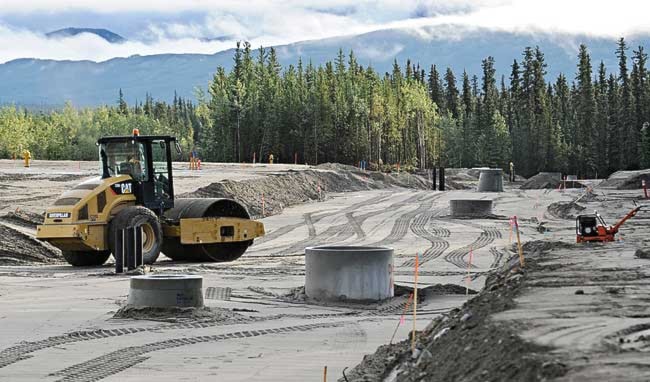For the Yukon Conservation Society, the Whistle Bend subdivision is becoming a big disappointment.
The original plans called for leaving large areas the natural greenspace intact, but recently a whole swath of land has been cleared.
“All of a sudden there’s this massive clearcut happening,” said Lewis Rifkind, mining co-ordinator for the Yukon Conservation Society. “The project is still ongoing, but the whole concept of a somewhat green subdivision is being lost and the project is changing.”
When the phase one construction began, it soon became obvious the design was flawed.
“It turns out that the soil conditions weren’t quite as favourable as we thought,” said Kinden Kosic, a city planner who has been working on the subdivision.
“To ensure that we have proper drainage to keep homes safe from flooding a little bit more clearing had to happen than we thought,” he said.
The contour mapping that shaped the original designs was done from aerial photos.
The actual lay of the land turned out to be a bit different, said Kosic.
“There’s a few humps in there that keep the water from flowing in a certain direction, that, combined with the soil conditions that are not as uniform as we originally thought, meant a few areas had to be pregraded to make sure that the water flowed properly,” he said.
To ensure proper drainage, trees had to be cleared and hundreds of thousands of cubic metres of soil and gravel brought in to raise up road and lot levels.
The Yukon government is embroiled in a lawsuit with a Whistle Bend contractor, Norcope Enterprises, over how that $2.1-million worth of extra work was awarded.
Not only was there an unexpected clearing of land for the redesign, but other natural features were destroyed as well.
A sand dune that was to be protected under the original plans was dug up and used for fill.
It turned out that Norcope, who had won a $15.9 million contract to build the water and utility infrastructure, didn’t have its own supply of gravel.
According to court documents filed by the Yukon government, Norcope never said it planned to use a subcontractor to supply gravel. That violated the terms of the tender documents and the contract.
The government gave Norcope permission to mine the sand dune “in an effort to assist” them with the work required under the redesign.
None of this sits well with the Conservation Society.
“If you get such a difference between what is proposed and discussed and what eventually ends up happening, it’s throwing into question a lot of the consultation processes,” said Rifkind.
Whistle Bend originally contained other environmental initiatives, like geothermal heating.
That idea was scrapped early.
“It turned out to be wildly cost prohibitive,” said Kosic. “It’s not fallen completely by the wayside, we’re just looking at doing things on a smaller scale, some pilot projects to see what will work.”
After looking at photos of what’s been done with the first phase of Whistle Bend, Rifkind is not very optimistic the rest of the development.
“Any positive environmental benefits were seeing are just being whittled away,” said Rifkind. “This is not a green, or even greenish-tinged development any more, it’s just another subdivision.”
“Sure you can revegetate, you can rebuild a lookout feature, but that’s not the point,” he said. “The whole idea was to retain the original things.
“Why not create a completely artificial landscape, pave the whole thing and just put flower boxes on it?”
Contact Josh Kerr at
joshk@yukon-news.com
